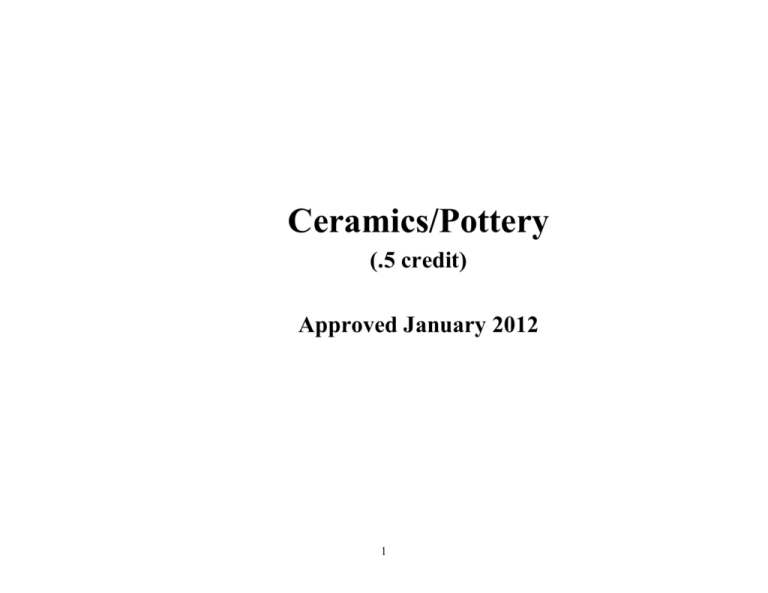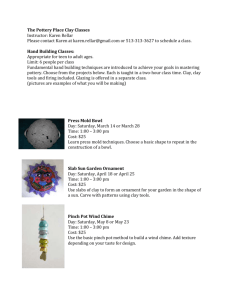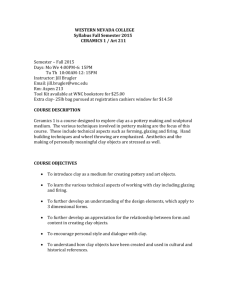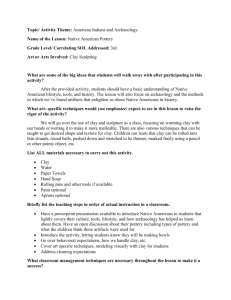Focus/ Course Title
advertisement

Ceramics/Pottery (.5 credit) Approved January 2012 1 Introduction to Clay Essential Understandings: 1. Working with clay media combines personal expression with form and function. 2. Varied qualities, conditions, tools, and techniques that are specific to knowledge of clay influence artistic production. 3. Clay art both reflects and informs the culture that creates it and promotes aesthetic interpretations Content Standards: 1. Understand, select and apply media, techniques and processes. 2. Understand and apply elements and organizational principles of art. 3. Consider, select and apply a range of subject matter, symbols and ideas. 4. Understand the visual arts in relation to history and culture. 5. Reflect upon, describe, analyze, interpret and evaluate their own and others’ work. 6. Make connections between the visual arts, other disciplines, and daily life. Essential Questions: How is clay made? How will basic knowledge of clay conditions, tools, techniques, and processes provide a foundation for clay artworks? How did the discovery of clay as a material to form objects impact the daily life and culture of early man? Learning Goals: Students will: Learn and correctly use the art vocabulary associated with ceramics/pottery. Identify the different states of clay and the limitations of each state. Develop the ability to wedge clay correctly. Exhibit responsible and cooperative practices in the use and maintenance of the studio. Learn about the first historical references to clay objects. Experiment with clay processes and techniques in forming pinch pots. Apply reading, and listening skills through articles and multimedia study of clay basics. 2 Suggested Strategies Suggested Assessments Suggested Resources Suggested Tech Integration Content Vocabulary Lifelong Learning/21st Century Skills Students introduce peers to the pottery studio using art vocabulary. Students demonstrate use of equipment, health, and safety rules after introduction of material. Students explain and perform studio jobs. Students form a series of pinch pots in order to experience states of clay and early construction technique. Students read and view information on basic clay knowledge. CFA – Pinch Pot Exercises Daily Teacher Observation Reading questions Quiz Performance assessment (self and teacher) of final pinch pot project. Article: “Clay the Basic Material” with reading questions Video: Creating with Ceramics – Crystal Video Handouts: Pinch Pot Exercises, Ceramic Facts, and Glossary of Terms Handout: Studio Responsibilities, Health & Safety Guidelines. Website: www.ceramicsartsdaily.org Website: http://www.ceramicstudies.me.uk/ Glossary of Pottery Terms; i.e. earthenware, wedging, plasticity, leather-hard, bone dry, kiln, pinch pot Productive habits of mind Quality work Read critically Communicate effectively Collaborate and cooperate Core Ethical Values 3 History of Ceramics Essential Understandings: 1. Working with clay media combines personal expression with form and function. 2. Varied qualities, conditions, tools, and techniques that are specific to knowledge of clay influence artistic production. 3. Clay art both reflects and informs the culture that creates it and promotes aesthetic interpretations Content Standards: 1. Understand, select and apply media, techniques and processes. 2. Understand and apply elements and organizational principles of art. 3. Consider, select and apply a range of subject matter, symbols and ideas. 4. Understand the visual arts in relation to history and culture. 5. Reflect upon, describe, analyze, interpret and evaluate their own and others’ work. 6. Make connections between the visual arts, other disciplines, and daily life. Essential Question: How does an object made of clay reflect and inform the culture in which it was created? How do aesthetic qualities contribute to an effective clay object? Learning Goals: Students will: Classify by genre, style, historical period or culture, representative examples of pottery. Explore ways in which the content of other disciplines is interrelated with pottery. Interpret the cultural and historical motifs visually expressed on pottery. Demonstrate, adapt and apply cultural or historical motifs in creating a clay object. Keep a record of ideas, thoughts, progress, and artwork through regular journal entries. Develop the ability to assess one’s work and the work of others through class critiques and individual analysis. 4 Suggested Strategies Suggested Assessments Suggested Resources Suggested Tech Integration Content Vocabulary Lifelong Learning/21st Century Skills Students read from a selection of articles on the history of ceramics. Students create a pictorial timeline depicting significant developments and discoveries related to ceramics. Students compare and contrast ceramic artworks from Pre-Columbian, Egyptian, Greek, Asian and contemporary cultures. Students create a clay artwork applying a cultural or historical reference. CFA – Association of visual symbols depicted by culture or historical period. Reading questions Performance assessment - Visual Timeline Project Performance assessment (self and teacher) of final clay artwork. Article: “Pottery – Clay in the life of man” Article: “Ceramics…an introduction” Scholastic Art Magazines: Art of the Americas, Pre-Columbian Ceramists, Egyptian Art, Greek Vase Painting Pottery Studio Library - resource books in studio Ceramic History for Potter’s - http://www.ceramicstudies.me.uk/ Ceramic Collections Online from Metropolitan Museum of Art, Brooklyn Museum, Museum of Fine Arts Glossary of Ceramic History terms, i.e.: Lascaux, Willendorf Venus, beehive kiln, refractory, plaiting Productive habits of mind Quality work Read critically Communicate effectively Access and process information Core Ethical Values 5 Hand-Building Essential Understandings: 1. Working with clay media combines personal expression with form and function. 2. Varied qualities, conditions, tools, and techniques that are specific to knowledge of clay influence artistic production. 3. Clay art both reflects and informs the culture that creates it and promotes aesthetic interpretations. Content Standards: 1. Understand, select and apply media, techniques and processes. 2. Understand and apply elements and organizational principles of art. 3. Consider, select and apply a range of subject matter, symbols and ideas. 4. Understand the visual arts in relation to history and culture. 5. Reflect upon, describe, analyze, interpret and evaluate their own and others’ work. 6. Make connections between the visual arts, other disciplines, and daily life. Essential Questions: What do hand-built clay artworks reveal about history or a culture? What hand-building techniques(s), tools, and processes best express your ideas? What are the qualities of an effective hand-built artwork? Learning Goals: Students will: Develop the ability to join clay properly. Develop the ability to use pinch pot, coil, slab, and pressed mold hand-building techniques. Develop sensitivity to the states of clay and limitations of each state. Investigate decorative techniques including texture, slip, and combination forms. Develop the ability to select and use appropriate pottery tools. Develop the ability to assess one’s work. Keep a record of ideas, thoughts, progress, and projects through regular journal entries. Investigate how clay objects and forms are used as evidence in describing and analyzing cultural and historical content. Investigate how subjects, symbols, and ideas have been applied to clay art throughout human history to communicate meaning. Research current pottery trends, ceramicists/potters, and mass-produced clay design. 6 Suggested Strategies Suggested Assessments Suggested Resources Suggested Tech Integration Content Vocabulary Lifelong Learning/21st Century Skills Students model pinch pot, coil, slab, and pressed mold hand-built construction techniques. Students identify the characteristics of each state of clay as clay art is created. Students explore decorative clay surface techniques/embellishments after modeling demonstration. Students explore purpose of each pottery tool after modeling demonstration. Students record goals for each day and reflect on outcome in journal. Students research subjects, symbols and forms associated with ancient cultures and interpret their meaning within the context of the culture. Students study and reflect upon contemporary ceramics/pottery and its meaning within a cultural context. Performance based/criteria sheet and rubric (self & teacher evaluated) for each clay artwork Journal writing Ceramics Monthly article summary #1 (CRHS writing standards) Scholastic Art Magazine i.e. Greek Vase Painting, article and questions, Pre-Columbian Ceramists, article and questions. Daily Teacher Observation Class critique Clay resource books housed in Pottery Studio, i.e. Simply Pottery, The Potter, Coil Pottery Ceramics Monthly Magazine Scholastic Art Magazines Handouts created by teacher Sample Projects Website: http://www.ceramicstudies.me.uk/ Website: www.ceramicsartsdaily.org Power Point of student work Glossary of Pottery Terms; i.e. coil, slab, slip, score, reinforcing coil, incise, plasticity, leather hard, bone dry Productive habits of mind Quality work Read critically Collaborate and cooperate Access and process information Core Ethical Values 7 Wheel Thrown Pottery Essential Understandings: 1. Working with clay media combines personal expression with form and function. 2. Varied qualities, conditions, tools, and techniques that are specific to knowledge of clay influence artistic production. 3. Clay art both reflects and informs the culture that creates it and promotes aesthetic interpretations. Content Standards: 1. Understand, select and apply media, techniques and processes. 2. Understand and apply elements and organizational principles of art. 3. Consider, select and apply a range of subject matter, symbols and ideas. 4. Understand the visual arts in relation to history and culture. 5. Reflect upon, describe, analyze, interpret and evaluate their own and others’ work. 6. Make connections between the visual arts, other disciplines, and daily life. Essential Questions: What do wheel thrown clay artworks reveal about history or a culture? What wheel thrown techniques(s), tools, and processes can best express your ideas? What are the qualities of an effective wheel thrown artwork? Learning Goals: Students will: Gain knowledge of the historical development of wheel thrown pottery and techniques. Understand the process of throwing on the wheel. Develop the ability to throw pots on the wheel. Show consistent progress throughout the semester by throwing more challenging forms. Develop the ability to select and use appropriate pottery tools. Gain knowledge about the use of kilns. Develop the ability to assess one’s work. Record and reflect ideas, thoughts, progress, and projects through consistent journal entries. Learn about current potters and current pottery trends. 8 Suggested Strategies Suggested Assessments Suggested Resources Suggested Tech Integration Content Vocabulary Lifelong Learning/21st Century Skills Students practice throwing a cylinder on the wheel after modeling demonstration. Students identify the steps in throwing a form on the wheel. Students explore purpose of each pottery tool as it applies to wheel throwing. Students record goals for each day and reflect on outcomes in journal. Students research subjects, symbols and forms associated with ancient cultures and interpret their meaning within the context of the culture. Study and reflect upon contemporary ceramics/pottery and its meaning within a cultural context. Performance based/criteria sheet and rubric (self & teacher evaluated) for each clay artwork Journal entries. Ceramics Monthly article summary #2 (CRHS writing standards) Class critique Daily Teacher Observation Introduction Article: “Throwing on the Wheel” with reading questions Video: Throwing on the Wheel – from Stephen Jepson series Pottery Studio Library - resource books in studio Handouts created by teacher Ceramics Monthly Magazine Sample Projects Website: http://www.ceramicstudies.me.uk/ Website: www.ceramicsartsdaily.org Power Point of student work Glossary of Pottery Terms; i.e. centering, opening, shaping, concentric, trimming, compressing the rim Productive habits of mind Quality work Read critically Communicate effectively Collaborate and cooperate Access and process information Core Ethical Values 9 Surface Treatments Essential Understandings: 1. Working with clay media combines personal expression with form and function. 2. Varied qualities, conditions, tools, and techniques that are specific to knowledge of clay influence artistic production. 3. Clay art both reflects and informs the culture that creates it and promotes aesthetic interpretations. Content Standards: 1. Understand, select and apply media, techniques and processes. 2. Understand and apply elements and organizational principles of art. 3. Consider, select and apply a range of subject matter, symbols and ideas. 4. Understand the visual arts in relation to history and culture. 5. Reflect upon, describe, analyze, interpret and evaluate their own and others’ work. 6. Make connections between the visual arts, other disciplines, and daily life. Essential Questions: How can clay surface treatments add elaboration and meaning to clay objects? What techniques(s), tools, and processes best express your ideas? How have ceramic artists used surface design techniques throughout history to depict symbols and stories of their culture? Learning Goals: Students will: Experiment with a variety of clay surface design techniques. Apply surface design treatments to clay tiles demonstrating use of proper tools and techniques. Select and apply surface design treatments to elaborate and communicate specific expression on a clay artwork. Identify surface design techniques in examples of clay objects from different cultures and historical periods. Develop the ability to assess one’s work and the work of others through class critiques and individual analysis. Record and reflect ideas, thoughts, progress, and projects through consistent journal entries. Gain knowledge of current potters and current pottery trends. 10 Suggested Strategies Suggested Assessments Suggested Resources Suggested Tech Integration Content Vocabulary Lifelong Learning/21st Century Skills Students match a surface design treatment with the corresponding tool or technique used for its creation. Students watch demonstration of clay surface techniques: sgraffito (incising), carving, appliqué, pressing, texturing, embossing, stenciling, inlaying, slip trailing, and piercing. Students will demonstrate a variety of surface treatments on a series of small clay tiles. Students will choose surface treatment(s) and apply to their own work to express aesthetic and contextual ideas. Students will identify and comment on surface treatment in cultural and historical clay objects. Students will reflect in their journals on comparative themes in different cultures. CFA – Hands on activity to use hands and fingers to create a variety of surface treatments. Students will demonstrate understanding of clay surface treatment on sample tiles. Quiz – Vocabulary associated with surface design and techniques Teacher Observation Performance assessment - Use of surface treatment incorporated into project assessments. Journal writing Pottery Studio Library - resource books in studio Sample tiles Handouts Ceramics Monthly Magazine Website: www.ceramicsartsdaily.org Website: http://pottery.about.com/ Website: http://www.ehow.com/ Glossary of Surface Design Terms; i.e. incise, sgraffito, appliqué, pierce, emboss, carve, relief. Productive habits of mind Quality work Read critically Communicate effectively Collaborate and cooperate Access and process information Core Ethical Values 1 11 Glazing and Finishes Essential Understandings: 1. Working with clay media combines personal expression with form and function. 2. Varied qualities, conditions, tools, and techniques that are specific to knowledge of clay influence artistic production. 3. Clay art both reflects and informs the culture that creates it and promotes aesthetic interpretations. Content Standards: 1. Understand, select and apply media, techniques and processes. 2. Understand and apply elements and organizational principles of art. 3. Consider, select and apply a range of subject matter, symbols and ideas. 4. Understand the visual arts in relation to history and culture. 5. Reflect upon, describe, analyze, interpret and evaluate their own and others’ work. 6. Make connections between the visual arts, other disciplines, and daily life. Essential Question: How can glaze and finish applications contribute to one’s presentation of an idea? Learning Goals: Students will: Gain knowledge of glaze and finish tools, techniques, and processes. Develop the ability to select and apply glaze and finishes. Investigate decoration combining multiple glaze techniques. Develop the ability to assess one’s work and the work of others through class critiques and individual analysis. Record and reflect ideas, thoughts, progress, and projects through consistent journal entries. Gain knowledge of current potters and current pottery trends. 12 Suggested Strategies Suggested Assessments Suggested Resources Suggested Tech Integration Content Vocabulary Lifelong Learning/21st Century Skills Students identify the physical spaces in the pottery studio where glaze samples, materials, and tools are used. Students watch demonstrations of glazes procedures and record procedures in journals for reference. Students prepare sample tiles to experiment with glazing techniques and finishes. Students glaze one project with bucket glazes, one project with LUG underglazes, and one project with FSeries glazes Students record their glaze combinations in journal and note their responses to the outcome of the project. Students share glaze information and outcomes to determine best glaze combinations and processes. Students will demonstrate understanding of glazing and finishes on sample tiles. Quiz – Vocabulary associated with glazing and finishing. Teacher Observation Performance assessment - Use of glazing and finishing as incorporated into project assessments. Journal – Documentation of glazes, finishes, and techniques used and student response to outcomes. Pottery Studio Library - resource books in studio Sample tiles Handouts on glaze processes, techniques and glaze combinations. Ceramics Monthly Magazine Sample Projects http://ceramicartsdaily.org/category/pottery-making-techniques/ceramic-glazing-techniques/ http://pottery.about.com/od/applyingglazes/tp/5applyglaze.htm http://www.ehow.com/videos-on_7467_pottery-glazing-techniques.html Glossary of Glazing Terms; i.e., wax resist, glaze claws, cleaning back, cone, underglaze, beading, crawling Productive habits of mind Quality work Collaborate and cooperate Access and process information Core Ethical Values 13






